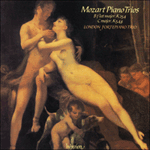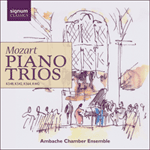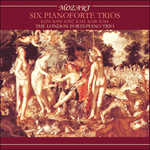
Welcome to Hyperion Records, a British classical label devoted to presenting high-quality recordings of music of all styles and from all periods from the twelfth century to the twenty-first.
Hyperion offers both CDs, and downloads in a number of formats. The site is also available in several languages.
Please use the dropdown buttons to set your preferred options, or use the checkbox to accept the defaults.

The first movement of the trio opens confidently, with assertive octaves played by all three instruments, answered delicately and questioningly by the piano. Soon there are flamboyant runs in both piano and violin suggesting that, despite the opening exchange, this trio is going to be uncomplicated in tone. The central development draws out rather a different story. The contrasts of the opening return, the assertive octaves are now in minor keys and alternate with sighing phrases and chromatic shifts. The piano attempts to introduce more flamboyant arpeggios, but the sighing phrases persist, and when the assertive opening theme returns, one is left with the feeling that there is an element of bravura in the confidence. This sense is reinforced by the occasional hesitant touch of minor keys during the reprise and the return of the sighing phrases as the overtly cheerful movement works towards its conclusion.
Similar dark hints also colour the slow movement. The calm of the opening theme is disturbed by sudden accents. A second, more expansive theme, is taken up yearningly by the cello, and a delicate third theme is coloured by dark chromatic touches in its harmonies. It is the middle of the movement that takes us furthest away from the calm decorations of the opening melody. The three instruments combine in octaves once more, but now fiercely. Florid runs from the beginning of the movement are answered by snatches of the expansive second theme, but now combined with shifts of harmony that create a more searching and unsettled impression.
The third movement has the innocent charm of several of Mozart’s piano concerto finales. There are more little chromatic touches in the principal theme, but by now they are playful rather than serious. There is a central episode in C minor, in which variants of the opening figure call to each other from instrument to instrument, and the movement begins to take on a suggestion of Beethoven-like urgency. But this is short lived, and Mozart works back to C major, side-stepping the first theme to plunge straight into the middle of the opening material. When he does eventually return to the first theme, it has acquired witty little decorations, which take on a mock-clumsy air when imitated by the violin. And at the end of the movement, one of the hesitant chromatic moments from the early part of the movement is reiterated, delaying the music in its tracks. But the emphatic conclusion, with the three instruments combining cheerfully in octaves for the last time, makes it clear that any dark elements have by now been thoroughly vanquished.
from notes by Robert Philip © 2007
Le premier mouvement du trio s’ouvre avec assurance sur de péremptoires octaves jouées par les trios instruments, auxquelles le piano répond de manière délicate et interrogative. Puis de flamboyants passages au piano et au violon suggèrent bientôt que, malgré l’échange initial, ce trio va adopter un ton simple. Le développement central raconte une histoire plutôt différente. Les contrastes du début réapparaissent et les octaves péremptoires se retrouvent désormais dans des tonalités mineures, alternant avec des phrases soupirantes et des changements chromatiques. Le piano tente d’introduire de nouveaux arpèges flamboyants, mais les phrases soupirantes persistent et, quand le péremptoire thème d’ouverture revient, on a le sentiment que toute cette assurance n’est pas dénuée d’un soupçon de bravoure—un sentiment que renforcent l’occasionnelle et hésitante touche de tonalités mineures durant la reprise, mais aussi le retour de phrases soupirantes, tandis que le mouvement ouvertement enjoué marche vers sa conclusion.
D’aussi sombres nuances colorent le mouvement lent. La quiétude du thème d’ouverture est troublée par des accents soudains, puis un deuxième thème, davantage expansif est langoureusement repris par le violoncelle, avant qu’un délicat troisième thème ne voie ses harmonies teintées de sombres touches chromatiques. C’est le milieu du mouvement qui nous éloigne le plus des paisibles décorations de la mélodie d’ouverture. Les trois instruments se recombinent en octaves, mais avec acharnement cette fois. Les passages fleuris du début du mouvement trouvent une réponse dans les bribes du deuxième mouvement expansif, dont la combinaison avec des changements d’harmonie crée une impression plus pénétrante et instable.
Le troisième mouvement a le charme innocent de plusieurs finales de concertos pour piano mozartiens. Les petites touches chromatiques sont plus nombreuses dans le thème principal, mais elles sont aussi plus espiègles que sérieuses. Dans l’épisode central, en ut mineur, des variantes de la figure d’ouverture s’appellent d’instrument en instrument et le mouvement commence à se teinter d’une certaine insistance beethovénienne. Mais elle est éphémère et Mozart revient à ut majeur, éludant le premier thème pour plonger droit au cœur du matériau d’ouverture. Lorsqu’il revient enfin au premier thème, ce dernier a gagné de spirituels petits ornements, qui prennent un tour pseudo-disgrâcieux lorsque le violon les imite. À la fin du mouvement, l’un des moments chromatiques hésitants de la première partie du mouvement est réitéré, retardant la musique dans son cheminement. Mais la conclusion emphatique, avec les trois instruments se combinant allègrement en octaves pour la dernière fois, montre que les éléments sombres ont tous été profondément vaincus.
extrait des notes rédigées par Robert Philip © 2007
Français: Hypérion
Der erste Satz des Trios beginnt selbstbewusst, mit nachdrücklichen Oktaven, die von allen drei Instrumenten gespielt werden, und denen das Klavier delikat und fragend antwortet. Bald finden sich extravagante Läufe in Klavier und Violine, die anzudeuten scheinen, dass der Ton dieses Trios, trotz des anfänglichen Austauschs, unkompliziert ist. Die zentrale Durchführung erzählt eine ganz andere Geschichte. Die Kontraste des Anfangs kehren wieder, wobei die selbstsicheren Oktaven des Anfangs jetzt in Moll erscheinen und mit Seufzerfiguren und chromatischen Verschiebungen abwechseln. Das Klavier versucht, glänzendere Arpeggien einzuführen, aber die Seufzerfiguren beharren, und wenn das resolute Anfangsthema zurückkehrt, behält man das Gefühl, dass in seiner Selbstsicherheit ein gewisses Element von Bravour enthalten ist. Dieses Gefühl wird durch den gelegentlichen zaghaften Hauch von Moll während der Reprise und die Rückkehr der Seufzerfiguren verstärkt, wenn dieser nach außen hin fröhliche Satz zum Abschluss kommt.
Ähnlich dunkle Anklänge färben auch den langsamen Satz. Die Ruhe des Anfangsthemas wird durch plötzliche Akzente gestört. Ein expansiveres zweites Thema, wird sehnsüchtig vom Cello übernommen, und ein delikates drittes Thema wird durch dunkel-chromatische Anklänge in seiner Harmonik gefärbt. Die Mitte des Satzes führt uns am weitesten von den zarten Verzierungen der Anfangsmelodie weg. Die drei Instrumente vereinen sich wiederum in jetzt aber grimmigen Oktaven. Zierreiche Läufe vom Anfang des Satzes werden mit Fetzen des expansiven zweiten Themas beantwortet, hier aber mit harmonischen Verschiebungen kombiniert, die einen eindringlicheren und unruhigen Eindruck hinterlassen.
Der dritte Satz besitzt den gleichen naiven Charme wie mehrere der Finales in Mozarts Klavierkonzerten. Im Hauptthema finden sich weitere sachte chromatische Anklänge, aber jetzt sind sie eher spielerisch als ernst. In einer zentralen Episode in c-Moll tauschen die Instrumente Varianten der Einleitungsfigur aus, und der Satz erhält allmählich eine nahezu beethovensche Dringlichkeit. Diese dauert jedoch nicht an, und Mozart arbeitet sich nach C-Dur zurück und umgeht das erste Thema, um sich direkt in die Mitte des Anfangsmaterials zu stürzen. Wenn er schließlich zum ersten Thema zurückkehrt, hat es sich launige kleine Schnörkel angeeignet, die sich pseudo-tollpatschig geben, wenn die Violine sie imitiert. Am Ende des Satzes wird einer der zögernden chromatischen Momente von früher im Satz wiederholt und bringt die Musik fast zum Stillstand. Aber der emphatische Schluss, in dem alle drei Instrumente zum letzten Mal fröhlich in Oktaven miteinander einstimmen, macht klar, dass alle dunkleren Elemente nunmehr gründlich überwunden wurden.
aus dem Begleittext von Robert Philip © 2007
Deutsch: Renate Wendel
 Mozart: Piano Trios K254 & 548 Mozart: Piano Trios K254 & 548«Un enregistrement remarquable» (Diapason, France)» More |
 Mozart: Piano Trios K548, 542 & 564 Mozart: Piano Trios K548, 542 & 564Teasing, flirtatious, tender, elusive, anguished, charming and magical are all words used by performer and classical specialist, Diana Ambache, to describe these three Mozart piano trios, written in his last three year.» More |
 Mozart: Six Piano Trios Mozart: Six Piano Trios |

